Kristine Hughes's Blog, page 78
March 25, 2015
WATERLOO WEDNESDAY - AT AUCTION: WELLINGTON, WATERLOO AND THE NAPOLEONIC WARS
Thank God for the 200th Anniversary of the Battle of Waterloo - Wellington is finally back in the spotlight thanks to all the buzz surrounding the host of upcoming Waterloo events in the news. I've gone from mentions of Wellington being akin to needles in haystacks to his being in the forefront of celebratory events. Huzzah!
Speaking of Wellington related events (as seemingly everyone does nowadays) on April 1, 2015, Bonham's, London, will hold their sale Wellington, Waterloo and the Napoleonic Wars. You can view the entire auction catalogue at the Bonham's site here, but in the meantime we've rounded up a few lots from the sale that will illustrate the variety of items that will be included in the sale. Get down to Coutts Bank and draw out some banker's drafts - there are sure to be a few items that will no doubt tempt you to buy.
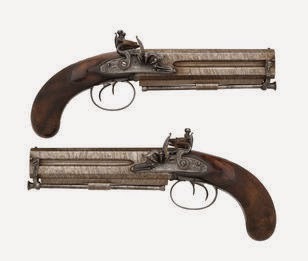
A Pair of 25-Bore Over-And-Under Flintlock Officer's Pistols
Signed E. Baker, London, Early 19th CenturyWith rebrowned twist octagonal sighted barrels each signed along the top flat, breeches each with gold line and platinum-lined touch-hole, signed border engraved flat bevelled locks decorated with foliage and starbursts, rainproof pans, rollers and engraved safety-catches, chequered figured rounded butts, border engraved steel trigger-guards each decorated with a martial trophy and foliage, vacant silver escutcheons, and stirrup ramrods, maker's special proof marks (2)
17.8 cm. barrelsFOOTNOTESEzekiel Baker (1758-1836) inventor of the Baker rifle and author of Remarks on Rifle Guns (1801), was Gunmaker-in-Ordinary to King George IV. He was influential in the King's shooting and collecting, and thus played an important role in the formation of the Carlton House Armoury
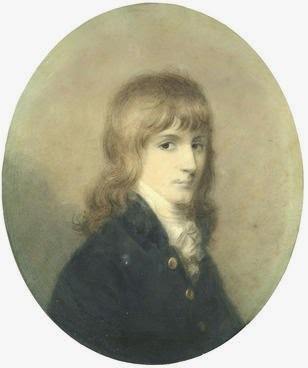
Lot 35JAMES GREEN(British, 1771-1834)Portrait of Napoleon Bonaparte (1769-1821), First Emperor of the French (1804-1815), aged twenty, in a gilt wood frame£1,000 - 1,500
US$ 1,500 - 2,300
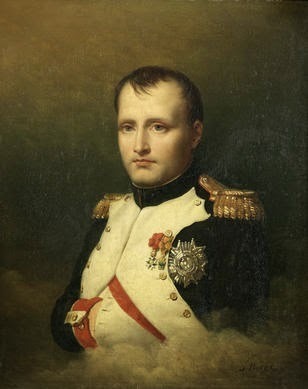
Lot 45CHARLES AUGUSTE STEUBEN(German, 1788-1856)Portrait of Napoleon£5,000 - 8,000
US$ 7,700 - 12,000
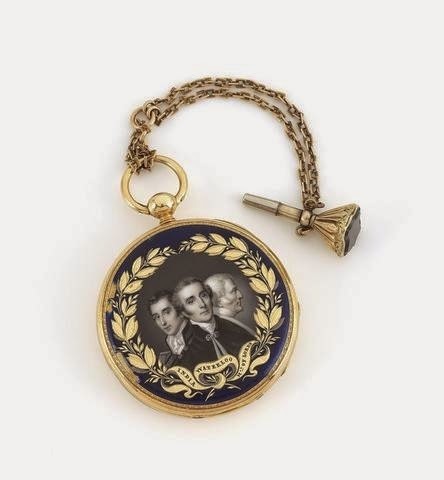
Lot 69MOULINIÉ, GENÈVE. A 19TH CENTURY 18CT GOLD KEY WIND OPEN FACE POCKET WATCH WITH TRIPLE ENAMEL PORTRAIT OF THE DUKE OF WELLINGTONCase & Cuvette No.26361, Circa 1830£15,000 - 25,000
US$ 23,000 - 38,000
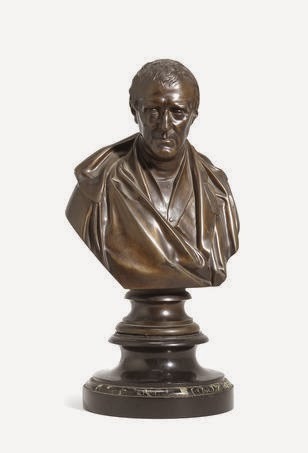
Lot 77MATTHEW NOBLE (1817-1876):Arthur Wellesley, First Duke of Wellington,£1,500 - 2,000
US$ 2,300 - 3,100
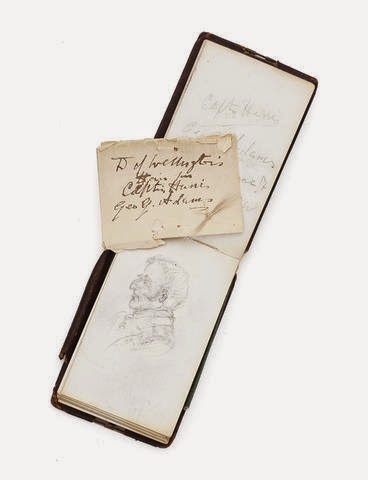
Lot 88WELLINGTON'S HAIRLock of the Duke of Wellington's hair, tied with tread, in a slip of paper inscribed "D. of Wellington's Hair for Captain Harris. Geor. G. Adams" and the date "1857 January 5", retained in the pocket of George Gammon Adams' pocket sketchbook; 126 Sloane Street. London S.W., [1857]£600 - 800
US$ 920 - 1,200

Lot 102THE SWORD WORN BY LT. GENERAL SIR G. COOK K.C.B. AT THE BATTLE OF QUATRE BRAS AND WATERLOOBy R. Johnston, Late Bland & Foster, Sword Cutler & Belt Maker to his Majesty, 68 St. James's Street, London, Early 19th Century
£15,000 - 20,000
US$ 23,000 - 31,000
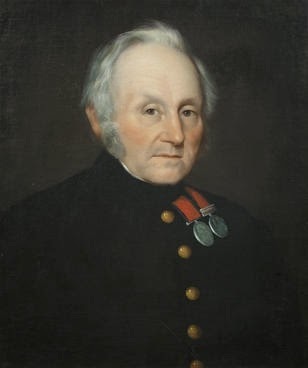
Lot 106ENGLISH SCHOOL, 19TH CENTURYPortrait of John Siddall (1788-1856), Veterinary Surgeon for the Royal Horse Guards at Waterloo, seated, bust length wearing a blue millitary tunic and the Army General Service Medal and the Waterloo Medal£1,000 - 1,500
US$ 1,500 - 2,300
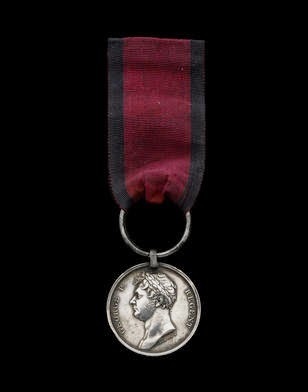
Lot 128WATERLOO MEDAL 1815,£1,500 - 2,000
US$ 2,300 - 3,100
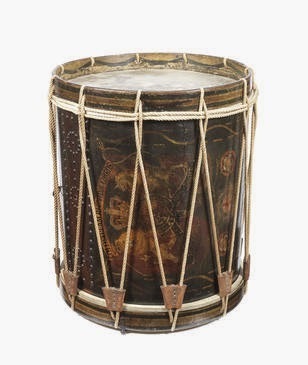
Lot 142A VERY RARE WATERLOO PERIOD CEREMONIAL BASE-DRUM OF THE COLDSTREAM REGIMENT OF FOOT GUARDSCirca 1810£6,000 - 8,000
US$ 9,200 - 12,000
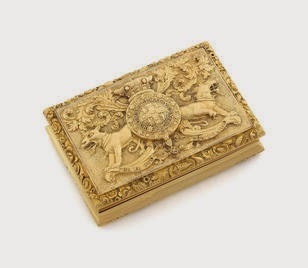
Lot 152LORD UXBRIDGE (1ST MARQUESS OF ANGELESEY): A GEORGE IV 18 CARAT GOLD IRISH FREEDOM BOXby Edward Murray, Dublin 1827£50,000 - 70,000
US$ 77,000 - 110,000
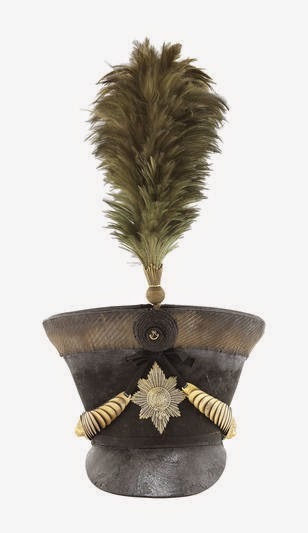
Lot 157AN EXTREMELY RARE 1822-26 PATTERN FULL DRESS SHAKO OF A LIGHT COMPANY OFFICER OF THE GRENADIER GUARDS£5,000 - 7,000
US$ 7,700 - 11,000
Speaking of Wellington related events (as seemingly everyone does nowadays) on April 1, 2015, Bonham's, London, will hold their sale Wellington, Waterloo and the Napoleonic Wars. You can view the entire auction catalogue at the Bonham's site here, but in the meantime we've rounded up a few lots from the sale that will illustrate the variety of items that will be included in the sale. Get down to Coutts Bank and draw out some banker's drafts - there are sure to be a few items that will no doubt tempt you to buy.

A Pair of 25-Bore Over-And-Under Flintlock Officer's Pistols
Signed E. Baker, London, Early 19th CenturyWith rebrowned twist octagonal sighted barrels each signed along the top flat, breeches each with gold line and platinum-lined touch-hole, signed border engraved flat bevelled locks decorated with foliage and starbursts, rainproof pans, rollers and engraved safety-catches, chequered figured rounded butts, border engraved steel trigger-guards each decorated with a martial trophy and foliage, vacant silver escutcheons, and stirrup ramrods, maker's special proof marks (2)
17.8 cm. barrelsFOOTNOTESEzekiel Baker (1758-1836) inventor of the Baker rifle and author of Remarks on Rifle Guns (1801), was Gunmaker-in-Ordinary to King George IV. He was influential in the King's shooting and collecting, and thus played an important role in the formation of the Carlton House Armoury

Lot 35JAMES GREEN(British, 1771-1834)Portrait of Napoleon Bonaparte (1769-1821), First Emperor of the French (1804-1815), aged twenty, in a gilt wood frame£1,000 - 1,500
US$ 1,500 - 2,300

Lot 45CHARLES AUGUSTE STEUBEN(German, 1788-1856)Portrait of Napoleon£5,000 - 8,000
US$ 7,700 - 12,000

Lot 69MOULINIÉ, GENÈVE. A 19TH CENTURY 18CT GOLD KEY WIND OPEN FACE POCKET WATCH WITH TRIPLE ENAMEL PORTRAIT OF THE DUKE OF WELLINGTONCase & Cuvette No.26361, Circa 1830£15,000 - 25,000
US$ 23,000 - 38,000

Lot 77MATTHEW NOBLE (1817-1876):Arthur Wellesley, First Duke of Wellington,£1,500 - 2,000
US$ 2,300 - 3,100

Lot 88WELLINGTON'S HAIRLock of the Duke of Wellington's hair, tied with tread, in a slip of paper inscribed "D. of Wellington's Hair for Captain Harris. Geor. G. Adams" and the date "1857 January 5", retained in the pocket of George Gammon Adams' pocket sketchbook; 126 Sloane Street. London S.W., [1857]£600 - 800
US$ 920 - 1,200

Lot 102THE SWORD WORN BY LT. GENERAL SIR G. COOK K.C.B. AT THE BATTLE OF QUATRE BRAS AND WATERLOOBy R. Johnston, Late Bland & Foster, Sword Cutler & Belt Maker to his Majesty, 68 St. James's Street, London, Early 19th Century
£15,000 - 20,000
US$ 23,000 - 31,000

Lot 106ENGLISH SCHOOL, 19TH CENTURYPortrait of John Siddall (1788-1856), Veterinary Surgeon for the Royal Horse Guards at Waterloo, seated, bust length wearing a blue millitary tunic and the Army General Service Medal and the Waterloo Medal£1,000 - 1,500
US$ 1,500 - 2,300

Lot 128WATERLOO MEDAL 1815,£1,500 - 2,000
US$ 2,300 - 3,100

Lot 142A VERY RARE WATERLOO PERIOD CEREMONIAL BASE-DRUM OF THE COLDSTREAM REGIMENT OF FOOT GUARDSCirca 1810£6,000 - 8,000
US$ 9,200 - 12,000

Lot 152LORD UXBRIDGE (1ST MARQUESS OF ANGELESEY): A GEORGE IV 18 CARAT GOLD IRISH FREEDOM BOXby Edward Murray, Dublin 1827£50,000 - 70,000
US$ 77,000 - 110,000

Lot 157AN EXTREMELY RARE 1822-26 PATTERN FULL DRESS SHAKO OF A LIGHT COMPANY OFFICER OF THE GRENADIER GUARDS£5,000 - 7,000
US$ 7,700 - 11,000
Published on March 25, 2015 00:30
March 23, 2015
LYING WITH A VENGEANCE
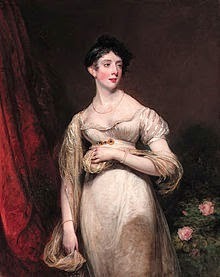
From the Journal of Mrs. Arbuthnot, March 24, 1822
The Duke (of Wellington) told us a good story he heard from Lady Cowper (above). When she was at Brighton the King talked to her of her mother, Lady Melbourne (by whom the King was supposed to have had a son, Geo Lamb) and said he used, during her last illness, to walk across the parade to her house every day, see her constantly and said that at last she died in his arms!! Lady Cowper knowing all the time that for the last ten days of her mother's life she never was out of her room and that, so far from the King calling to see her or having her die in his arms, he never even sent to enquire after her. This is lying with a vengeance!
Published on March 23, 2015 00:00
March 20, 2015
LOOSE IN LONDON: ROYAL CHILDHOOD EXHIBITION

Victoria here. If I hadn't already known that Buckingham Palace was exhibiting a collection about Royal Childhood, I would have been rather shocked to see a Rocking Horse in the Green Drawing Room leading into the Throne Room.


But there it was, just as it looked when Princesses Elizabeth and Margaret Rose sat upon it decades ago.
In fact, all through the palace were a few toys and dolls upon the sofas and tables in the stately gilded rooms, and looking not at all out of place for a house that is often home to several generations of children. The Exhibition closed in September 2014, but you can read more about it here.
 One of the oldest displays, a handwriting practice book of George IV, 1767
One of the oldest displays, a handwriting practice book of George IV, 1767 The Buckingham Palace Ballroom fitted out as an exhibition hall
The Buckingham Palace Ballroom fitted out as an exhibition hallIn addition to dolls and toys in various rooms of the Palace, a large exhibition was mounted in the Ballroom with many display cases for clothing, toys, and memorabilia.
 Childhood clothing over centuries
Childhood clothing over centuries Worn by George V in 1868
Worn by George V in 1868 Visitors enjoying the exhibition
Visitors enjoying the exhibition Cradle of Princess Alice, 1843
Cradle of Princess Alice, 1843 Queen Elizabeth II's Dolls
Queen Elizabeth II's DollsEnhancing the objects were many photos and films of the Royal children,In an exhibition review in the Telegraph, July 28, 2014, Richard Dorment wrote, "It goes without saying that, from a material point of view, royal children have everything any child could want and more. But none of that means anything without a family life based on parental love and the affection of siblings. What knits the show together and gives everything we’ve seen the context it needs to bring it to life is the selection of deeply private home movies on view in the ball room. Particularly touching are the grainy films showing the touching relationship between the Queen and her sister Princess Margaret, seen practicing dance steps or playing with their corgis under the amused and clearly doting gaze of their parents."
 Princess Elizabeth and her Doll-Buggy
Princess Elizabeth and her Doll-Buggy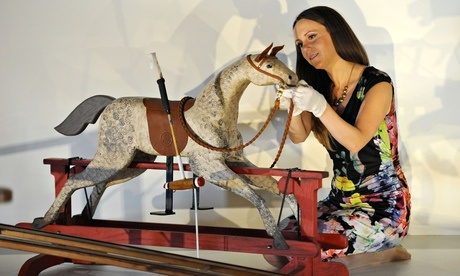 Royal Collection Curator Anna Reynolds with a rocking horse sent by President and Mrs. Obama to Prince William of Cambridge
Royal Collection Curator Anna Reynolds with a rocking horse sent by President and Mrs. Obama to Prince William of Cambridge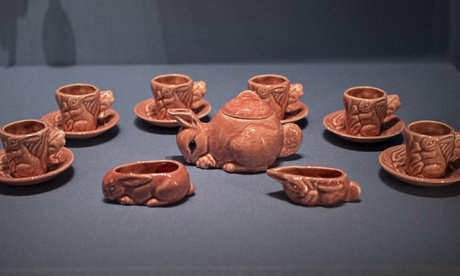 A Tea Set played with by Princess Elizabeth in the 1930's
A Tea Set played with by Princess Elizabeth in the 1930's George, Prince of wales, and Frederick, later Duke of York, at Buckingham House, 1765by Johan Zoffany(1733-1810)
George, Prince of wales, and Frederick, later Duke of York, at Buckingham House, 1765by Johan Zoffany(1733-1810)To end our account of the Royal Childhood Exhibition, we go back to the beginning. to show this portrait of the earliest days of Buckingham House as a royal home. The first two offspring of George III and Queen Charlotte were not yet "breeched" in this painting. George would have been almost three and Frederick almost two years of age.
Published on March 20, 2015 00:00
March 18, 2015
VIDEO WEDNESDAY: LIFE BELOW STAIRS
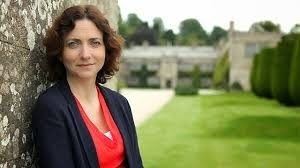
"The Real Downton Abbey" Servants: The True Story Of Life Below StairsA century ago, 1.5 million British people worked as servants – astonishingly, more than worked in factories or farms. But while servants are often portrayed as characters in period dramas, the real stories of Britain’s servants have largely been forgotten. Presented by social historian Dr Pamela Cox - herself the great-granddaughter of servants - this three-part series uncovers the reality of servants’ lives from the Victorian era through to the Second World War.
Click here to watch Part One
Published on March 18, 2015 00:00
March 16, 2015
FASHIONS FOR 1815
Victoria here sharing a few of my fashion plates from magazines of 1815. At one time, I owned most of the 1815 and 1816 La Belle Assemblee volumes and plates, now residing in the Chawton House Library. I have kept digital and printed copies for my own use, but they will reach a better audience there. I still have a few from Ackermann's, so herewith :
What you'd be Wearing 200 years ago!
 La Belle Assemblée, February, 1815
La Belle Assemblée, February, 1815
From the magazine: "Parisian Costume: A short round dress of the finest light ruby Merino cloth, trimmed with narrow blue velvet, is worn over a cambric petticoat, no part of which is seen by the double flounce of the finest Valenciennes edging with which it is ornamented at the bottom. We refer our readers to the Print for the form of this dress. An elegant little cap of black velvet is put on over one of white lace, the lace border is disposed round the face in a very novel and becoming style. The hair is little seen on the forehead, and not at all on the neck, otherwise the fullness of lace would look much better; the cap is ornamented with a beautiful plume of white ostrich feathers, put on so as to fall over in front. White silk scarf with a border of intermingled blue and ruby. Black kid slippers, tied round the ancle (sic.) with a narrow black ribband; and white kid gloves. We have selected this dress because it is at present in the highest estimation amongst the Parisian elegantes; it is certainly original, and the materials are elegant, the scarf, in particular, is superb; its tout ensemble is truly French, and the admirers of Parisian fashions will, we think, agree with us, as to its being one of the most striking lately introduced in that tasteful metropolis. The dinner dress was invented by Mrs. Bell, Inventress of the Ladies Chapeau Bras and the Circassian Corsets, and of whom only it can be had, at her Magazin des Modes, No. 26, Charlotte-street, Bedford-square; of who also May be had the Parisian Costume as above described.
 Ackermann's, March 1815
Ackermann's, March 1815
This looks like just the ensemble for the chilly winds of March. But that hat would need a strong set of pins to keep it on her head.
Description from the magazine: "Walking Dress: Pelisse of short walking length, made of evening-primrose coloured velvet, ornamented down the front with satin trimming, round capes, trimmed to correspond, full lace ruff. A French bonnet, composed of white velvet and satin in reversed plaitings, trimmed round the edge with a quilting of lace, full plume of ostrich feathers in the front. Half-boots of tan-coloured kid. Gloves, Limerick or York tan."
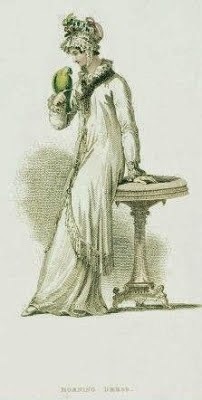 Ackermann's, April 1815
Ackermann's, April 1815
I love the parrot or budgie on her hand.
"Morning Dress: A loose robe of fine cambric or worked jaconot muslin, over a petticoat of the same, flounced with French trimming; long, full sleeve, confined at the wrist with treble drawings, and ornamented with corresponding trimming. The robe or neglige of demi-length, is confined at the top by a narrow collar or gathered into a Vandyke ruff, and is worn with coloured silk handkerchief, tied carelessly round the neck, and is fastened down the front with bows and tassels. A mob cap, composed of net and Brussels lace, decorated with a cluster of flowers, and bows of satin ribbon. Hair curled in the neck. Slippers or sandals of pale tan-coloured kid. Gloves en suite."
 La Belle Assemblée, May, 1815
La Belle Assemblée, May, 1815
Angouleme Walking Dress
Angouleme is an area of southwestern France. In 1799, the Duke of Angouleme married Marie Thérèse 1778-1851), eldest child of King Louis XVI of France and Queen Marie Antoinette. The Duke was the son of the eventual French King Charles X, who abdicated in 1830. As the niece of Louis XVIII. the Duchess was part of his entourage when he became King in 1814, and she accompanied him when he fled at Napoleon's return to Paris. Since I cannot locate the magazine's description of this plate, alas, I assume the ensemble is named for the Duchess in some regard.
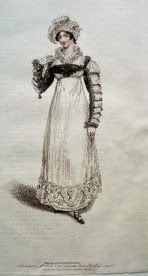 La Belle Assemblée July 1815
La Belle Assemblée July 1815
Waterloo Walking Dress: After the Battle, the publishers of this magazine must have raced to find a suitable dress to commemorate the battle, something in the colors of mourning for the dead, yet expressive of the victorious celebration throughout the nation. Do you think they succeeded?
From the magazine: "Waterloo Walking DressThis very beautiful dress, which answers the double purpose of walking or dinner dress, is composed of clear muslin and is made in a most original and tasteful style: the petticoat, as our readers will perceive by the Print, is ornamented in an elegant and appropriate manner with a tasteful black trimming. The body and sleeves, composed of an intermixture of black satin and clear muslin, are exquisitely fancied; they are made in a style of novelty, elegance, and simplicity which we never recollect being equalled in the mourning costume. The Waterloo dress, when worn for dinner parties, has no shirt, but some ladies shade the neck a little by a narrow frill of white crape round the bosom. In the walking costume it is worn with a shirt invented for the occasion, and trimmed in a very novel and appropriate style. Of the hat worn with this dress we can only observe that it is the most elegant and striking headdress ever invented for mourning; it is an intermixture of white satin and black crape, most tastefully ornamented with either black or white feathers. Black or white kid sandals and white kid gloves finish the dress, the effect of which altogether is much more elegant than our fair readers can conceive either from the Print or from our description. The above dress was invented by Mrs. Bell, Inventress of the Ladies Chapeau Bras and the Circassian Corset, and of whom only they can be had, at her Magazin des Modes, No. 26, Charlotte Street, Bedford-Square."
 La Belle Assemblée August 1815
La Belle Assemblée August 1815
The description below is particularly amusing, referring to ease of shedding the dress while in the bathing machine (see background drawing) ready to be 'plunged.'
“Sea Side Bathing Dress: This very elegant dress is composed of the newly introduced Berlin silk. It is made in the form of a pelisse, and is so contrived that the stays, petticoat, and pelisse are all put on in a few moments. A flounce of green gauze, crape, or muslin, edged with an exceedingly pretty silk trimming, ornaments the dress; which, when on, is so finished and elegant that no one could suppose it was possible to adjust it in a few moments. A Leghorn hat ornamented with a plume of straw colour feathers, and green plaid leather boots, finish this dress, which we look upon as a chef d’oeuvre in its way, since, independent of the advantage which it is to a lady to be able to dress and undress so quickly, the most fastidious belle must confess that nothing can possibly be more becoming than this Sea Side Bathing Dress. The Wellington corset, with which it is worn, is admirably adapted to display in the most easy and graceful manner the natural proportions of the shape; and the tout ensemble of this elegant and useful habit is simple, tasteful and in the highest degree appropriate.”
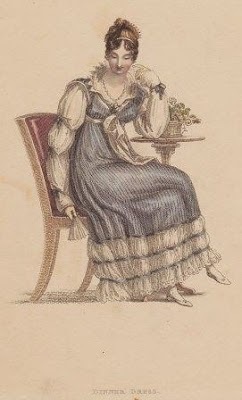 Ackermann's, September 1815
Ackermann's, September 1815
"Dinner Dress: A white satin slip worn under a dress made in primrose-coloured French gauze, terminating at the feet with a full flounce of blond lace, headed with a double border of the same, gathered in full, and confined with folds of satin, corresponding colours to the dress; handkerchief -front trimmed with white satin, and a falling collar of blond lace; long sleeve of white satin, the fulness upon the shoulder confined under an epaulet of the French gauze tried with white satin; the sleeve drawn alternately across the arm with the evening primrose coloured satin ribbon. Long white sash of white satin, tied in front. The ends of the hind hair brought forward, to fall in ringlets over the temple, confined with a plain white satin ribbon, and ornamented with a tiara of pearl. Necklace to correspond. Gloves, French kid. Slippers, white satin."
We will save the Autumn and Winter 1815 fashions for later in the year, In the meantime, if you know of any more description of the Angouleme Walking Dress from the May 1815 LBA, please let me know where to look. Thank you!!
What you'd be Wearing 200 years ago!
 La Belle Assemblée, February, 1815
La Belle Assemblée, February, 1815From the magazine: "Parisian Costume: A short round dress of the finest light ruby Merino cloth, trimmed with narrow blue velvet, is worn over a cambric petticoat, no part of which is seen by the double flounce of the finest Valenciennes edging with which it is ornamented at the bottom. We refer our readers to the Print for the form of this dress. An elegant little cap of black velvet is put on over one of white lace, the lace border is disposed round the face in a very novel and becoming style. The hair is little seen on the forehead, and not at all on the neck, otherwise the fullness of lace would look much better; the cap is ornamented with a beautiful plume of white ostrich feathers, put on so as to fall over in front. White silk scarf with a border of intermingled blue and ruby. Black kid slippers, tied round the ancle (sic.) with a narrow black ribband; and white kid gloves. We have selected this dress because it is at present in the highest estimation amongst the Parisian elegantes; it is certainly original, and the materials are elegant, the scarf, in particular, is superb; its tout ensemble is truly French, and the admirers of Parisian fashions will, we think, agree with us, as to its being one of the most striking lately introduced in that tasteful metropolis. The dinner dress was invented by Mrs. Bell, Inventress of the Ladies Chapeau Bras and the Circassian Corsets, and of whom only it can be had, at her Magazin des Modes, No. 26, Charlotte-street, Bedford-square; of who also May be had the Parisian Costume as above described.
 Ackermann's, March 1815
Ackermann's, March 1815This looks like just the ensemble for the chilly winds of March. But that hat would need a strong set of pins to keep it on her head.
Description from the magazine: "Walking Dress: Pelisse of short walking length, made of evening-primrose coloured velvet, ornamented down the front with satin trimming, round capes, trimmed to correspond, full lace ruff. A French bonnet, composed of white velvet and satin in reversed plaitings, trimmed round the edge with a quilting of lace, full plume of ostrich feathers in the front. Half-boots of tan-coloured kid. Gloves, Limerick or York tan."
 Ackermann's, April 1815
Ackermann's, April 1815I love the parrot or budgie on her hand.
"Morning Dress: A loose robe of fine cambric or worked jaconot muslin, over a petticoat of the same, flounced with French trimming; long, full sleeve, confined at the wrist with treble drawings, and ornamented with corresponding trimming. The robe or neglige of demi-length, is confined at the top by a narrow collar or gathered into a Vandyke ruff, and is worn with coloured silk handkerchief, tied carelessly round the neck, and is fastened down the front with bows and tassels. A mob cap, composed of net and Brussels lace, decorated with a cluster of flowers, and bows of satin ribbon. Hair curled in the neck. Slippers or sandals of pale tan-coloured kid. Gloves en suite."
 La Belle Assemblée, May, 1815
La Belle Assemblée, May, 1815Angouleme Walking Dress
Angouleme is an area of southwestern France. In 1799, the Duke of Angouleme married Marie Thérèse 1778-1851), eldest child of King Louis XVI of France and Queen Marie Antoinette. The Duke was the son of the eventual French King Charles X, who abdicated in 1830. As the niece of Louis XVIII. the Duchess was part of his entourage when he became King in 1814, and she accompanied him when he fled at Napoleon's return to Paris. Since I cannot locate the magazine's description of this plate, alas, I assume the ensemble is named for the Duchess in some regard.
 La Belle Assemblée July 1815
La Belle Assemblée July 1815Waterloo Walking Dress: After the Battle, the publishers of this magazine must have raced to find a suitable dress to commemorate the battle, something in the colors of mourning for the dead, yet expressive of the victorious celebration throughout the nation. Do you think they succeeded?
From the magazine: "Waterloo Walking DressThis very beautiful dress, which answers the double purpose of walking or dinner dress, is composed of clear muslin and is made in a most original and tasteful style: the petticoat, as our readers will perceive by the Print, is ornamented in an elegant and appropriate manner with a tasteful black trimming. The body and sleeves, composed of an intermixture of black satin and clear muslin, are exquisitely fancied; they are made in a style of novelty, elegance, and simplicity which we never recollect being equalled in the mourning costume. The Waterloo dress, when worn for dinner parties, has no shirt, but some ladies shade the neck a little by a narrow frill of white crape round the bosom. In the walking costume it is worn with a shirt invented for the occasion, and trimmed in a very novel and appropriate style. Of the hat worn with this dress we can only observe that it is the most elegant and striking headdress ever invented for mourning; it is an intermixture of white satin and black crape, most tastefully ornamented with either black or white feathers. Black or white kid sandals and white kid gloves finish the dress, the effect of which altogether is much more elegant than our fair readers can conceive either from the Print or from our description. The above dress was invented by Mrs. Bell, Inventress of the Ladies Chapeau Bras and the Circassian Corset, and of whom only they can be had, at her Magazin des Modes, No. 26, Charlotte Street, Bedford-Square."
 La Belle Assemblée August 1815
La Belle Assemblée August 1815The description below is particularly amusing, referring to ease of shedding the dress while in the bathing machine (see background drawing) ready to be 'plunged.'
“Sea Side Bathing Dress: This very elegant dress is composed of the newly introduced Berlin silk. It is made in the form of a pelisse, and is so contrived that the stays, petticoat, and pelisse are all put on in a few moments. A flounce of green gauze, crape, or muslin, edged with an exceedingly pretty silk trimming, ornaments the dress; which, when on, is so finished and elegant that no one could suppose it was possible to adjust it in a few moments. A Leghorn hat ornamented with a plume of straw colour feathers, and green plaid leather boots, finish this dress, which we look upon as a chef d’oeuvre in its way, since, independent of the advantage which it is to a lady to be able to dress and undress so quickly, the most fastidious belle must confess that nothing can possibly be more becoming than this Sea Side Bathing Dress. The Wellington corset, with which it is worn, is admirably adapted to display in the most easy and graceful manner the natural proportions of the shape; and the tout ensemble of this elegant and useful habit is simple, tasteful and in the highest degree appropriate.”
 Ackermann's, September 1815
Ackermann's, September 1815"Dinner Dress: A white satin slip worn under a dress made in primrose-coloured French gauze, terminating at the feet with a full flounce of blond lace, headed with a double border of the same, gathered in full, and confined with folds of satin, corresponding colours to the dress; handkerchief -front trimmed with white satin, and a falling collar of blond lace; long sleeve of white satin, the fulness upon the shoulder confined under an epaulet of the French gauze tried with white satin; the sleeve drawn alternately across the arm with the evening primrose coloured satin ribbon. Long white sash of white satin, tied in front. The ends of the hind hair brought forward, to fall in ringlets over the temple, confined with a plain white satin ribbon, and ornamented with a tiara of pearl. Necklace to correspond. Gloves, French kid. Slippers, white satin."
We will save the Autumn and Winter 1815 fashions for later in the year, In the meantime, if you know of any more description of the Angouleme Walking Dress from the May 1815 LBA, please let me know where to look. Thank you!!
Published on March 16, 2015 00:30
March 13, 2015
LOOSE IN LONDON: THE HISTORY OF BUCKINGHAM PALACE
Great Britain has no shortage of castles and palaces. London alone has plenty, think Hampton Court, Kensington, St James's, Lambeth -- and that's not to mention those now demolished.
 Buckingham Palace, Sunday, August 31. 2014
Buckingham Palace, Sunday, August 31. 2014
But there is one above all that we associated with the present-day Royal Family, and it might be a surprise to find that it has been the home of the monarch less than 200 years, beginning with Queen Victoria. Buckingham House, built for the Duke of Buckingham in 1701-03
Buckingham House, built for the Duke of Buckingham in 1701-03
The site of the present-day Palace and Garden belonged to various nobles and religious orders until the time of Henry VII, who took it the Manor of Ebury for himself from Westminster Abbey in 1536. James I created a mulberry garden on the site to feed what he hoped would become a silkworm industry in London. Several houses were built on the site and changed hands frequently. Designed by William Winde, the above mansion, which is still the core of the central part of the palace, was completed in 1703 for the Duke of Buckingham.
 The Queen's House
The Queen's House
In 1761, the new young King George III purchased and remodeled the building as a home for his new Queen, Charlotte of Mecklenburg-Strelitz (1744-1818). who bore most of their fifteen children in the house. During this period, the house was faced in red brick and had the appearance of Georgian country mansion -- which it was.
The Royal Family officially lived at St James's Palace, not far away. The Prince Regent, upon reaching his majority in 1783, was given Carlton House as his residence. The Prince began s series of remodeling projects that lasted until he became George IV in 1820, when he decided Carlton House was not sufficiently large and grand enough for a British Monarch.
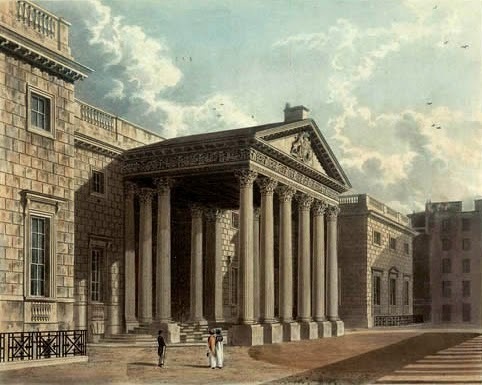 Carlton House demolished, 1825
Carlton House demolished, 1825
He and Architect John Nash, who also worked on his Brighton Pavilion, embarked on a series of structural and decorative embellishments to the Queen's House, renaming it Buckingham Palace. They added several wings into the forecourt and eventually constructed a triumphal arch to make a ceremonial entrance into the palace.
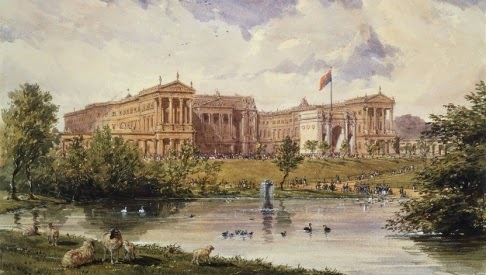 The Palace c. 1837
The Palace c. 1837
When Carlton House was demolished, many of the furnishings and interior decor fittings were moved into the "new" palace. George IV did not live to see completion of his masterpiece and after his death, poor John Nash was criticized for the chronic overspending and overly grand plans George pressed him to create. The new King in 1830 was George's brother William IV, not known for his interest in the arts, who lived at Clarence House. (See our visit to Clarence House here) Since the interiors at Buckingham Palace were neither finished nor to his (lack of) taste, King William and Queen Adelaide remained at Clarence House until his death in 1837.
. Buckingham Palace, 1837
Buckingham Palace, 1837
After the Houses of Parliament burned in 1834, King William IV suggested that Parliament might take over the unfinished Buckingham Palace and adapt it for the seats of the Houses of Commons and Lords. But this offer was rejected, and building continued, accelerating after Victoria became Queen in 1837.
Many of the rooms might have been splendid, but the palace was cold, ill-lit, smoky and uncomfortable. More repairs and alterations were planned, and continued after her marriage to Prince Albert of Saxe-Coburg-Gotha. who personally led some of the improvements.
In the mid-1840's, the wings were expanded and plans for a new section, which we know as the familiar front of the Palace, necessitated the relocation of the triumphal Arch.
 Marble Arch
Marble Arch
The Marble Arch was moved into the northeast corner of Hyde Park, but that site today is in the middle of a traffic circle. In order to facilitate the ever-growing volume of cars lorries and buses, the crucial intersection of Park Land, Edgware Road, and Oxford Street was widened by taking park land and isolating the Arch. At least it was cleaned up. It stands there today, a sort of monument to a by-gone era. The location of Tyburn Tree, a public execution site from 1388 to 1793, is nearby.
According to the Monarchy's website, "A serious problem for the newly married couple was the absence of any nurseries and too few bedrooms for visitors. The only solution was to move the Marble Arch - it now stands at the north-east corner of Hyde Park - and build a fourth wing, thereby creating a quadrangle. (Edward) Blore, the architect in charge, created the East Front and, thanks largely to his builder, Thomas Cubitt, the costs were reduced from £150,000 to £106,000. The cost of the new wing was largely covered by the sale of George IV's Royal Pavilion at Brighton. Blore added an attic floor to the main block of the Palace and decorated it externally with marble friezes originally intended for Nash's Marble Arch. The work was completed in 1847."
 The Palace East Wing as it appeared in 1910
The Palace East Wing as it appeared in 1910
Victoria and Albert also had a grand ballroom built to accommodate various official events and balls. It opened in 1856, at that time, the largest room in London.
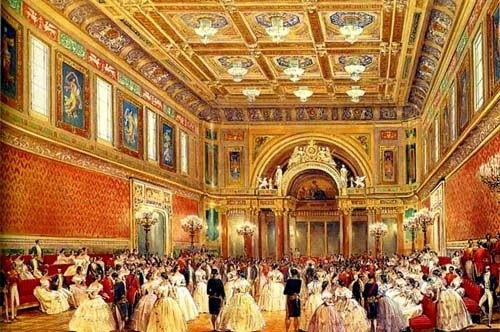 The Opening Ball in the new Ballroom, 1856
The Opening Ball in the new Ballroom, 1856
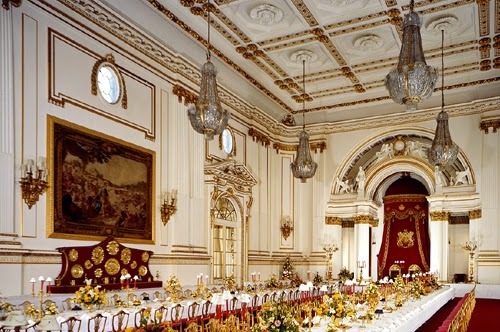 The Ballroom set up for a large dinner party
The Ballroom set up for a large dinner party
 Victoria Memorial, 2014
Victoria Memorial, 2014
Shortly after her death, Queen Victoria's eldest son successor, Edward VII, called for a memorial to the Queen and Empress. Sir Thomas Brock created the sculpture and the base was designed by Sir Aston Webb. The project was not completed until 1924
Because pollution had discolored and pitted the stone of the East Wing, its face was replaced in 1913 by a facade of white Portland Stone. Sir Aston Webb was in charge, and the work was finished in the summer of 1914, just before the outbreak of World War I.
 The present Portland Stone facade of the East Front, 2010
The present Portland Stone facade of the East Front, 2010
During World War II, German bombs hit the Palace seven times. Queen Elizabeth and King George VI remained in residence. The Queen said, "I'm glad we have been bombed. Now I can look the East End in the face". She could certainly sympathize with the oft-bombed residents of East London.
 King George VI and Queen Elizabeth in the Palace after an air attack
King George VI and Queen Elizabeth in the Palace after an air attack
The Balcony on the East Front is the national and international focal point for the celebration of great events.
 Celebrating the end of World War II in 1945
Celebrating the end of World War II in 1945
 After the 1953 Coronation of Queen Elizabeth II
After the 1953 Coronation of Queen Elizabeth II
 After the wedding of Prince William and Kate Middleton
After the wedding of Prince William and Kate Middleton
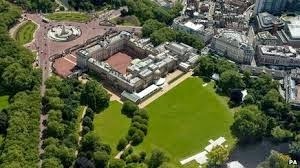 An Aerial View
An Aerial View
As it stands today, Buckingham Palace has 775 rooms, used for state occasions, personal and guest apartments, nearly 100 offices, and 78 bathrooms. It is a working palace and often hosts state dinners. Below, the March, 2015, visit of the President and First Lady of Mexico, with the Queen and Prince Philip.

 Buckingham Palace, Sunday, August 31. 2014
Buckingham Palace, Sunday, August 31. 2014But there is one above all that we associated with the present-day Royal Family, and it might be a surprise to find that it has been the home of the monarch less than 200 years, beginning with Queen Victoria.
 Buckingham House, built for the Duke of Buckingham in 1701-03
Buckingham House, built for the Duke of Buckingham in 1701-03The site of the present-day Palace and Garden belonged to various nobles and religious orders until the time of Henry VII, who took it the Manor of Ebury for himself from Westminster Abbey in 1536. James I created a mulberry garden on the site to feed what he hoped would become a silkworm industry in London. Several houses were built on the site and changed hands frequently. Designed by William Winde, the above mansion, which is still the core of the central part of the palace, was completed in 1703 for the Duke of Buckingham.
 The Queen's House
The Queen's HouseIn 1761, the new young King George III purchased and remodeled the building as a home for his new Queen, Charlotte of Mecklenburg-Strelitz (1744-1818). who bore most of their fifteen children in the house. During this period, the house was faced in red brick and had the appearance of Georgian country mansion -- which it was.
The Royal Family officially lived at St James's Palace, not far away. The Prince Regent, upon reaching his majority in 1783, was given Carlton House as his residence. The Prince began s series of remodeling projects that lasted until he became George IV in 1820, when he decided Carlton House was not sufficiently large and grand enough for a British Monarch.
 Carlton House demolished, 1825
Carlton House demolished, 1825He and Architect John Nash, who also worked on his Brighton Pavilion, embarked on a series of structural and decorative embellishments to the Queen's House, renaming it Buckingham Palace. They added several wings into the forecourt and eventually constructed a triumphal arch to make a ceremonial entrance into the palace.
 The Palace c. 1837
The Palace c. 1837When Carlton House was demolished, many of the furnishings and interior decor fittings were moved into the "new" palace. George IV did not live to see completion of his masterpiece and after his death, poor John Nash was criticized for the chronic overspending and overly grand plans George pressed him to create. The new King in 1830 was George's brother William IV, not known for his interest in the arts, who lived at Clarence House. (See our visit to Clarence House here) Since the interiors at Buckingham Palace were neither finished nor to his (lack of) taste, King William and Queen Adelaide remained at Clarence House until his death in 1837.
.
 Buckingham Palace, 1837
Buckingham Palace, 1837After the Houses of Parliament burned in 1834, King William IV suggested that Parliament might take over the unfinished Buckingham Palace and adapt it for the seats of the Houses of Commons and Lords. But this offer was rejected, and building continued, accelerating after Victoria became Queen in 1837.
Many of the rooms might have been splendid, but the palace was cold, ill-lit, smoky and uncomfortable. More repairs and alterations were planned, and continued after her marriage to Prince Albert of Saxe-Coburg-Gotha. who personally led some of the improvements.
In the mid-1840's, the wings were expanded and plans for a new section, which we know as the familiar front of the Palace, necessitated the relocation of the triumphal Arch.
 Marble Arch
Marble ArchThe Marble Arch was moved into the northeast corner of Hyde Park, but that site today is in the middle of a traffic circle. In order to facilitate the ever-growing volume of cars lorries and buses, the crucial intersection of Park Land, Edgware Road, and Oxford Street was widened by taking park land and isolating the Arch. At least it was cleaned up. It stands there today, a sort of monument to a by-gone era. The location of Tyburn Tree, a public execution site from 1388 to 1793, is nearby.
According to the Monarchy's website, "A serious problem for the newly married couple was the absence of any nurseries and too few bedrooms for visitors. The only solution was to move the Marble Arch - it now stands at the north-east corner of Hyde Park - and build a fourth wing, thereby creating a quadrangle. (Edward) Blore, the architect in charge, created the East Front and, thanks largely to his builder, Thomas Cubitt, the costs were reduced from £150,000 to £106,000. The cost of the new wing was largely covered by the sale of George IV's Royal Pavilion at Brighton. Blore added an attic floor to the main block of the Palace and decorated it externally with marble friezes originally intended for Nash's Marble Arch. The work was completed in 1847."
 The Palace East Wing as it appeared in 1910
The Palace East Wing as it appeared in 1910Victoria and Albert also had a grand ballroom built to accommodate various official events and balls. It opened in 1856, at that time, the largest room in London.
 The Opening Ball in the new Ballroom, 1856
The Opening Ball in the new Ballroom, 1856 The Ballroom set up for a large dinner party
The Ballroom set up for a large dinner party Victoria Memorial, 2014
Victoria Memorial, 2014Shortly after her death, Queen Victoria's eldest son successor, Edward VII, called for a memorial to the Queen and Empress. Sir Thomas Brock created the sculpture and the base was designed by Sir Aston Webb. The project was not completed until 1924
Because pollution had discolored and pitted the stone of the East Wing, its face was replaced in 1913 by a facade of white Portland Stone. Sir Aston Webb was in charge, and the work was finished in the summer of 1914, just before the outbreak of World War I.
 The present Portland Stone facade of the East Front, 2010
The present Portland Stone facade of the East Front, 2010During World War II, German bombs hit the Palace seven times. Queen Elizabeth and King George VI remained in residence. The Queen said, "I'm glad we have been bombed. Now I can look the East End in the face". She could certainly sympathize with the oft-bombed residents of East London.
 King George VI and Queen Elizabeth in the Palace after an air attack
King George VI and Queen Elizabeth in the Palace after an air attackThe Balcony on the East Front is the national and international focal point for the celebration of great events.
 Celebrating the end of World War II in 1945
Celebrating the end of World War II in 1945 After the 1953 Coronation of Queen Elizabeth II
After the 1953 Coronation of Queen Elizabeth II After the wedding of Prince William and Kate Middleton
After the wedding of Prince William and Kate Middleton An Aerial View
An Aerial ViewAs it stands today, Buckingham Palace has 775 rooms, used for state occasions, personal and guest apartments, nearly 100 offices, and 78 bathrooms. It is a working palace and often hosts state dinners. Below, the March, 2015, visit of the President and First Lady of Mexico, with the Queen and Prince Philip.

Published on March 13, 2015 00:30
March 11, 2015
WATERLOO WEDNESDAY: WATERLOO AT WINDSOR

By Guest Blogger Nicola Cornick
There can be few places more appropriate than Windsor Castle to hold an exhibition to commemorate the 200thanniversary of the Battle of Waterloo. Originally founded by William the Conqueror at the end of the 11th century, Windsor has been home to 39 monarchs and is the oldest royal residence in the British Isles. At various points in its history it has undergone major remodelling and one of these took place in the late 18th and early 19th century with the creation of a new grand staircase and state apartments. During the Peninsular Wars when there was a threat to the country from republican France, Windsor was recognised as a symbolic bastion of the British nation and the monarchy.
It was George IV who created the Waterloo Chamber in celebration of the allied victory of 1815, and the room was completed by his successor William IV. It is a vast pace filled with Sir Thomas Lawrence’s imposing portraits of those who were instrumental in the victory, including the Duke of Wellington. A portrait of George himself is placed at the centre of the room and thus as the focal point of the victory.

The “Waterloo at Windsor” exhibition is running throughout this year and I was lucky enough to go and see it a couple of weeks ago. It’s a fascinating mixture of prints, drawings and archive material from the Royal Collection, which explore the battle and its aftermath. The introduction to the exhibition is via the Drawings Gallery where there is a display of maps of the battlefield and paintings that were in some cases produced in the immediate aftermath of the battle, showing tourists already visiting the site. I also loved the collection of Rowlandson cartoons depicting Napoleon as a Corsican bloodhound and it was interesting to see some French propaganda cartoons and pictures, showing him from a very different perspective, that of the peacemaker of Europe. I also learned some fascinating facts; that amongst the memorials planned after the battle was one for a pyramid as high as St Paul’s Cathedral, which would have cost a million pounds in the currency of the day. Like many of the proposed memorials it was never built.

Elsewhere in the staterooms are a whole host of artefacts with connections to the battle. By far my favourite was Napoleon’s burnous, a red felt hooded cloak lined with yellow silk brocade and decorated with silver braid (above). This had been found amongst Napoleon’s baggage train on the field at Waterloo and was presented to the Prince Regent by General Blucher. Also taken from Napoleon’s belongings was a leather travelling desk, decorated with gold bees and the monogram “N.” It contained two inkpots, a sandbox, a candlestick and bell. Napoleon certainly didn’t travel light!
It was the little details of the exhibition that I enjoyed the most: The drawing of the Waterloo Elm, which had been Wellington’s command post during the battle, and the story that it was subsequently stripped of its leaves and branches by souvenir hunters and turned into a chair! The gorgeous silver gilt tea service and toast racks that Napoleon gave to his adopted daughter Stephanie on her marriage… Each item had a different story to tell and a different light to shed not only the Battle of Waterloo itself but also on the enigmatic Emperor who continued to be a figure of fascination even in exile.
Throughout 2015, Waterloo at Windsor: 1815–2015 will combine a themed trail through the State Apartments with a display of prints, drawings and archival material that explores the battle and its aftermath.
The trail will highlight objects seized on the battlefield by the victors, including silver, furniture, weapons and the beautiful red cloak belonging to Napoleon, presented to George IV by Wellington's ally, Field-Marshal Gebhardt von Blücher.

You can visit guest blogger and USA Today Best Selling Author Nicola Cornick's website here.
Published on March 11, 2015 00:00
March 9, 2015
TRAVELS WITH VICTORIA: BRITISH NOTABLES AT THE RINGLING MUSEUM OF ART IN FLORIDA
COMING HERE; REYNOLDS, GAINSBOROUGH, LAWRENCE, RAEBURN, BURNE-JONES...BUT FIRST...
Herewith a disclaimer! For many years, I went to the Circus Parade in Milwaukee. It was fantastic, with the many antique circus wagons from the Circus World Museum in Barbaboo, WI, pulled by teams of draft horses from all over the US. So I have to admit that both my visits to the Ringling Complex in Sarasota, FL, were disappointing when it came to the circus memorabilia. Much better to visit the Baraboo site if you are looking for old time circus material related to the Ringling Bros. Barnum and Bailey shows. However, Baraboo doesn't have the fantastic Ringling mansion or the wonderful Art Museum...for those, go to Sarasota.
 Great Circus Parade, Milwaukee, 2009
Great Circus Parade, Milwaukee, 2009
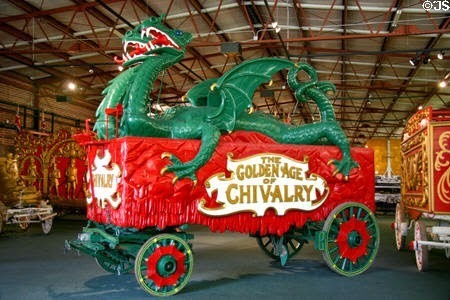 The Golden Age of Chivalry wagon at Baraboo
The Golden Age of Chivalry wagon at Baraboo
But the circus is not the subject of this post, other than the fact that the Ringling Brothers were from Baraboo, and John and Mable Ringling made their fortune from the circus, then built their mansion in Sarasota and gave their art collection to the people and the State of Florida.
In the fashion of numerous American millionaires in the early 20th century, Ringling spent time in Europe and acquired a massive collection of art, antiquities, furniture, and decorative art.
 Ca' d'Zan, Sarasota, FL
Ca' d'Zan, Sarasota, FL
Of course, I couldn't get far enough away or up in the air to take a photo like this, so this is from the website. To see more click here. Ca' d'Zan means House of John, but on the architect's plans, it was known as residence of Mrs John Ringling.
 Visitors file through the house almost every day.
Visitors file through the house almost every day.
Taking the inspiration from their many visits to Venice, the Ringlings hired architect Dwight James Baum to design the house -- with Mable's eager participation. After two years of construction, it was completed in 1926. Sadly, Mable was able to enjoy it for only three years before she died at age 54.
 Style: Venetian Gothic !
Style: Venetian Gothic !
John lived until 1936, having remarried and suffered from the effects of the Great Depression. His fortune had declined to almost nothing, but he insisted on leaving the house, grounds and Art Museum to the people and State of Florida. For many decades the property was neglected until it was used for the decrepit home of Miss Havisham in 1996 Hollywood version of Dickens' Great Expectations. The State of Florida and Florida State University have restored the house and grounds and renovated the Art Museum in the last couple of decades and it is in pristine shape today..
Now to the Art Museum Collection -- just like the Grand Tours that 18th Century young men took, so 19th and early 20th century American millionaires, craving cultural education and acquisition of treasures to prove their erudition, enjoyed touring continental cities, castles, and museums. In addition to hiring European circus performers for the Ringling Brothers Circus in the U.S., John and Mable Ringling bought and shipped many artworks; he was particularly attuned to baroque Italian art, according to guides at the museum. But he also bought many wonderful works in Great Britain.
 Marquis of Granby, 1766, by Sir Joshua Reynolds
Marquis of Granby, 1766, by Sir Joshua Reynolds
I think my absolute favorite here is a portrait of John Manners (1721-1770) the Marquis of Granby,1766, by Sir Joshua Reynolds (1723-1792). It was loaned to the Tate Britain for their Joshua Reynolds: Creation of Celebrity exhibition in 2005 (click here)-- and it may look rather familiar as portions of it are often seen on pub signs. Apparently many pubs, even today, are named after the famous general, who did not live long enough to succeed his father as Duke of Rutland. The Marquess was popular with his men and is said to have set up many of them in pubs of their own which they named after their benefactor.
 Lt. General Philip Honywood by Thomas Gainsborough, 1765
Lt. General Philip Honywood by Thomas Gainsborough, 1765
Reynolds' competitor, Thomas Gainsborough, (1727-1788), is represented by this fine military portrait with a beautiful landscape background. Honywood was a colleague of the Marquis of Granby in battle. One can see the evidence of Gainsborough's admiration of the equestrian portraits by Van Dyke in this work.
 Agrippina and her Children Mourning over the Ashes of Germanicus, 1773by Benjamin West
Agrippina and her Children Mourning over the Ashes of Germanicus, 1773by Benjamin West
American-born Benjamin West (1738-1820) moved to London in and never returned. He was the second president of the Royal Academy of Art, succeeding Sir Joshua Reynolds, He was an excellent painter of historical, mythological, and religious canvases, large in scope and accomplishment,
 Mr. Hope Vere of Blackwood, by Henry Raeburn, c. 1805
Mr. Hope Vere of Blackwood, by Henry Raeburn, c. 1805
Raeburn (1756-1823) was perhaps Scotland's greatest artist of his period. A miniaturist and self-taught portraitist, he married well and was able to travel to Italy and hone his talents. When he returned to Scotland, he painted many of Edinburgh's notables, including author Sir Walter Scott
 George IV when Prince of Wales, attributed to John Hoppner, c. 1792-1807
George IV when Prince of Wales, attributed to John Hoppner, c. 1792-1807
Hoppner (1758-1810) was one of the successors to Reynolds and Gainsborough for royal and aristocratic portraiture. He was born to a family from Bavaria that served the British court. Young Hoppner trained at the Royal Academy. The Prince's attire is portrayed colorfully in the grand tradition.
 The Sisters, c. 1810, by George Watson
The Sisters, c. 1810, by George Watson
This charming double portrait was once attributed to Henry Raeburn, but later identified as the work of George Watson (1778-1837), another Edinburgh painter of great accomplishment. Portrayed are Georgina and Elizabeth Reay of Killingworth Hall, Northumberland.
 Mrs. George Frederick Stratton, 1811, by Thomas Lawrence
Mrs. George Frederick Stratton, 1811, by Thomas Lawrence
Lawrence inherited the position of primary portraitist from Reynolds and Gainsborough in the Regency period in England. He was particularly influenced by Van Dyke, and it is said he never painted a non-beautiful woman.
 The Sirens, 1870 unfinished, by Edward Burne-Jones
The Sirens, 1870 unfinished, by Edward Burne-Jones
Burne-Jones (1833-1898) was one of the leading members of the pre-Raphaelite movement. This unfinished painting depicts a scene from Homer's The Odyssey, with the sailors' ship approaching the deadly Sirens.
 Roman Courtship, c. 1900, by Sir William Ernest Reynolds-Stephens
Roman Courtship, c. 1900, by Sir William Ernest Reynolds-Stephens
Reynolds-Stephens (1862-1943) was American born but trained and spent most of his working life in Europe. This picture shows the mythological figure of Morta holding the threads of life over the couple while Cupid drapes flowers over the woman, seeming to indicate her life will be short. The style was influenced by the pre-Raphaelites.
 Courtyard of the Ringling Museum of Art. Sarasota, FL
Courtyard of the Ringling Museum of Art. Sarasota, FL
This is just a sample of the treasures in the museum, from antiquities to 20th C. masters and contemporary works as well. Plan a visit!
Herewith a disclaimer! For many years, I went to the Circus Parade in Milwaukee. It was fantastic, with the many antique circus wagons from the Circus World Museum in Barbaboo, WI, pulled by teams of draft horses from all over the US. So I have to admit that both my visits to the Ringling Complex in Sarasota, FL, were disappointing when it came to the circus memorabilia. Much better to visit the Baraboo site if you are looking for old time circus material related to the Ringling Bros. Barnum and Bailey shows. However, Baraboo doesn't have the fantastic Ringling mansion or the wonderful Art Museum...for those, go to Sarasota.
 Great Circus Parade, Milwaukee, 2009
Great Circus Parade, Milwaukee, 2009 The Golden Age of Chivalry wagon at Baraboo
The Golden Age of Chivalry wagon at BarabooBut the circus is not the subject of this post, other than the fact that the Ringling Brothers were from Baraboo, and John and Mable Ringling made their fortune from the circus, then built their mansion in Sarasota and gave their art collection to the people and the State of Florida.
In the fashion of numerous American millionaires in the early 20th century, Ringling spent time in Europe and acquired a massive collection of art, antiquities, furniture, and decorative art.
 Ca' d'Zan, Sarasota, FL
Ca' d'Zan, Sarasota, FLOf course, I couldn't get far enough away or up in the air to take a photo like this, so this is from the website. To see more click here. Ca' d'Zan means House of John, but on the architect's plans, it was known as residence of Mrs John Ringling.
 Visitors file through the house almost every day.
Visitors file through the house almost every day.Taking the inspiration from their many visits to Venice, the Ringlings hired architect Dwight James Baum to design the house -- with Mable's eager participation. After two years of construction, it was completed in 1926. Sadly, Mable was able to enjoy it for only three years before she died at age 54.
 Style: Venetian Gothic !
Style: Venetian Gothic !John lived until 1936, having remarried and suffered from the effects of the Great Depression. His fortune had declined to almost nothing, but he insisted on leaving the house, grounds and Art Museum to the people and State of Florida. For many decades the property was neglected until it was used for the decrepit home of Miss Havisham in 1996 Hollywood version of Dickens' Great Expectations. The State of Florida and Florida State University have restored the house and grounds and renovated the Art Museum in the last couple of decades and it is in pristine shape today..
Now to the Art Museum Collection -- just like the Grand Tours that 18th Century young men took, so 19th and early 20th century American millionaires, craving cultural education and acquisition of treasures to prove their erudition, enjoyed touring continental cities, castles, and museums. In addition to hiring European circus performers for the Ringling Brothers Circus in the U.S., John and Mable Ringling bought and shipped many artworks; he was particularly attuned to baroque Italian art, according to guides at the museum. But he also bought many wonderful works in Great Britain.
 Marquis of Granby, 1766, by Sir Joshua Reynolds
Marquis of Granby, 1766, by Sir Joshua ReynoldsI think my absolute favorite here is a portrait of John Manners (1721-1770) the Marquis of Granby,1766, by Sir Joshua Reynolds (1723-1792). It was loaned to the Tate Britain for their Joshua Reynolds: Creation of Celebrity exhibition in 2005 (click here)-- and it may look rather familiar as portions of it are often seen on pub signs. Apparently many pubs, even today, are named after the famous general, who did not live long enough to succeed his father as Duke of Rutland. The Marquess was popular with his men and is said to have set up many of them in pubs of their own which they named after their benefactor.
 Lt. General Philip Honywood by Thomas Gainsborough, 1765
Lt. General Philip Honywood by Thomas Gainsborough, 1765 Reynolds' competitor, Thomas Gainsborough, (1727-1788), is represented by this fine military portrait with a beautiful landscape background. Honywood was a colleague of the Marquis of Granby in battle. One can see the evidence of Gainsborough's admiration of the equestrian portraits by Van Dyke in this work.
 Agrippina and her Children Mourning over the Ashes of Germanicus, 1773by Benjamin West
Agrippina and her Children Mourning over the Ashes of Germanicus, 1773by Benjamin West American-born Benjamin West (1738-1820) moved to London in and never returned. He was the second president of the Royal Academy of Art, succeeding Sir Joshua Reynolds, He was an excellent painter of historical, mythological, and religious canvases, large in scope and accomplishment,
 Mr. Hope Vere of Blackwood, by Henry Raeburn, c. 1805
Mr. Hope Vere of Blackwood, by Henry Raeburn, c. 1805Raeburn (1756-1823) was perhaps Scotland's greatest artist of his period. A miniaturist and self-taught portraitist, he married well and was able to travel to Italy and hone his talents. When he returned to Scotland, he painted many of Edinburgh's notables, including author Sir Walter Scott
 George IV when Prince of Wales, attributed to John Hoppner, c. 1792-1807
George IV when Prince of Wales, attributed to John Hoppner, c. 1792-1807Hoppner (1758-1810) was one of the successors to Reynolds and Gainsborough for royal and aristocratic portraiture. He was born to a family from Bavaria that served the British court. Young Hoppner trained at the Royal Academy. The Prince's attire is portrayed colorfully in the grand tradition.
 The Sisters, c. 1810, by George Watson
The Sisters, c. 1810, by George Watson This charming double portrait was once attributed to Henry Raeburn, but later identified as the work of George Watson (1778-1837), another Edinburgh painter of great accomplishment. Portrayed are Georgina and Elizabeth Reay of Killingworth Hall, Northumberland.
 Mrs. George Frederick Stratton, 1811, by Thomas Lawrence
Mrs. George Frederick Stratton, 1811, by Thomas LawrenceLawrence inherited the position of primary portraitist from Reynolds and Gainsborough in the Regency period in England. He was particularly influenced by Van Dyke, and it is said he never painted a non-beautiful woman.
 The Sirens, 1870 unfinished, by Edward Burne-Jones
The Sirens, 1870 unfinished, by Edward Burne-JonesBurne-Jones (1833-1898) was one of the leading members of the pre-Raphaelite movement. This unfinished painting depicts a scene from Homer's The Odyssey, with the sailors' ship approaching the deadly Sirens.
 Roman Courtship, c. 1900, by Sir William Ernest Reynolds-Stephens
Roman Courtship, c. 1900, by Sir William Ernest Reynolds-StephensReynolds-Stephens (1862-1943) was American born but trained and spent most of his working life in Europe. This picture shows the mythological figure of Morta holding the threads of life over the couple while Cupid drapes flowers over the woman, seeming to indicate her life will be short. The style was influenced by the pre-Raphaelites.
 Courtyard of the Ringling Museum of Art. Sarasota, FL
Courtyard of the Ringling Museum of Art. Sarasota, FLThis is just a sample of the treasures in the museum, from antiquities to 20th C. masters and contemporary works as well. Plan a visit!
Published on March 09, 2015 00:30
March 6, 2015
LOOSE IN LONDON: VICTORIA STANDS ALONE
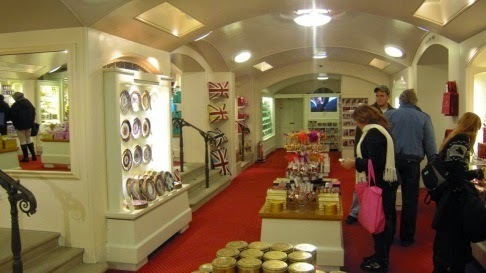 Queen's Gallery Gift Shop
Queen's Gallery Gift ShopSo there I stood in the gift shop of the Queen's Gallery Browsing. More browsing...downstairs to the facilities. Back up for more browsing...Ran into the Palace-uniformed woman who guided us around Clarence House on Sunday and we chat for a while. I go outside and sit in the shade. Then I sit in the sun. Go back inside...I know I am slow going through the exhibition and that I read every word of every text panel and label...so certainly I cannot be ahead of Kristine, Diane, and Marilyn by this much time. Where could they be?
 Queen's Gallery Entrance
Queen's Gallery EntranceCould I be paranoid enough to think they ditched me? That they went on to the Palace and are now enjoying a tete a tete with the Queen while I am just standing around? How long do I wait? I have my phone but Kristine doesn't have a phone that works in England....I wait some more.
Eventually, after what seemed like hours, I walked to the entrance of the Palace itself, the tourist entrance, that is. No friends awaited me. I turned in my ticket and went inside to sit in the tent...but the guards suggested I move along. That I was waiting for friends seemed not to matter. I must have looked suspicious because the guards definitely stood nearby and glared at me.
Where were Marilyn, Diane, and Kristine? I started visualizing the three of them walking through the gilded halls and giggling mean-girl fashion, thinking of me waiting outside, never to see the Palace.
How dare they? Eventually, under prodding by the guards and because I didn't want to sit around concocting scenarios in which I'd become the odd person out for the next two weeks and would have to tag along behind everyone else, I decided to forget about the situation and enjoy my trek through the Palace. Alone. Aren't we all trapped by the trials and tribulations of our junior high school experiences?
Fortunately, I am easily diverted and soon, if momentarily, forgot about being the ditched kid.
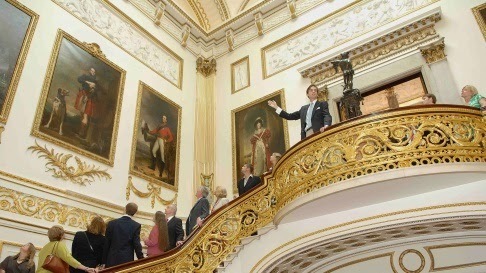 Up the Grand Staircase
Up the Grand StaircaseFor a virtual tour of the Grand staircase, click here.
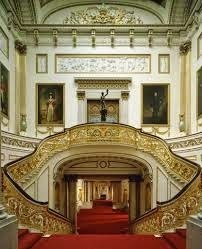 The Grand Staircase
The Grand StaircaseIn the manner of tourists everywhere, the crowd, while not immense, moved at varying rates of speedsome lingering to inspect various items or question the numerous uniformed guides, most of whom had ready answers for all the inquiries. The State Rooms are sumptuous, as you can tell from these pictures. They were decorated by Architect John Nash and George IV, who saw them as stage settings for the impressiveness of the King, the magnificence of the British monarchy.
 The Green Drawing Room, Anteroom to The Throne Room
The Green Drawing Room, Anteroom to The Throne Room The Throne Room
The Throne RoomThe Throne Rom is the home of thrones used in many coronation ceremonies over the years, set about the room. Guides stated that the only time Queen Elizabeth II sat on her throne was for her 1952 Coronation. The room is used for various ceremonial purposes, but I guess nobody sits down!
For a virtual tour of the Throne Room, click here.
 The Blue Drawing Room
The Blue Drawing RoomIt is an ironic amusement to me that the decor was so heavily influenced by the French styles of the 18th century, the time of Louis XIV, XV, and XVI. Despite the fact that Britain and France were almost continually at war in this period, the British aristocracy and particularly the Prince of Wales, aka the Prince Regent and eventually George IV, adored French art, architecture, and workmanship. It set the standard for the world.
For a virtual tour of the Blue Drawing Room, click here.
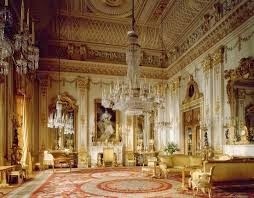 The White Drawing Room
The White Drawing RoomThe White Drawing Room is particularly elegant, with the lovely 1908 portrait of Queen Alexandra as the focal point.
 Queen Alexandra (1844-1925), 1908, by Francois Flemeng (1856-1923)
Queen Alexandra (1844-1925), 1908, by Francois Flemeng (1856-1923)According to the description in the Royal collection website, "This strikingly sophisticated and composed portrait of Queen Alexandra was painted by the French artist François Flameng in 1908. It is perhaps one the highlights of early 20th century royal portraiture. The Queen sits upon a stone step, she gazes directly at the viewer; dressed in a white silk dress, diaphanous gauze suggested about her arms and shoulders. She is wearing the riband and star of the Order of the Garter, a diamond choker, long string of pearls and small crown. A wooded landscape and suggestion of a building or castle in the background."
For a virtual tour of the White Drawing Room, click here.
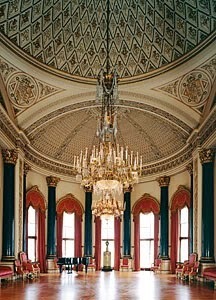 The Music Room, overlooking the gardens
The Music Room, overlooking the gardensThe Music Room is graced by large windows alternating with columns of scagliola made to resemble lapis lazuli. To read about a recent restoration of the columns by the firm of Hayles and Howe, click here.
 One of two chandeliers in the Music Room
One of two chandeliers in the Music RoomAttributed to Perry and Co., 72 New Bond Street. and originally made c. 1815, the two chandeliers were probably created for Carlton House, and later altered and rehung in Buckingham Palace. They are said to resemble the the chandelier in the Piccadilly Drawing Room at Apsley House, London. We shall see!
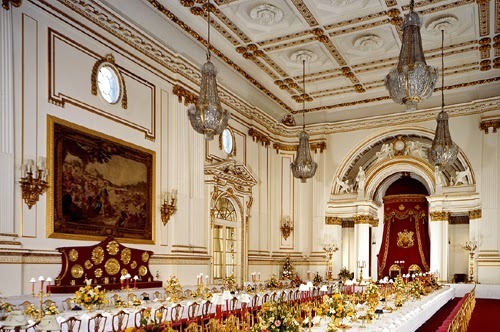 The Ballroom, arranged for a formal dinner
The Ballroom, arranged for a formal dinnerMost of the State Rooms were originally decorated by Nash and George IV, but later changes were made by Queen Victoria, such as the building of this large ballroom in 1856. When I was there in September, 2014, it was arranged as the main exhibition area for the Royal Childhood exhibition which we will cover in a later post.
 In the Picture Gallery
In the Picture GalleryAs I strolled through the picture gallery I felt my cell phone vibrating. There were signs around warning visitors not to use mobile phones, However, I sneaked a peek -- the call was coming from Diane! I didn't even know she had a phone with her. I did not dare to answer. She followed up with a text, "Where are you?" At this point, I consulted one of the guards -- was there any place I could stand and do a text silently? "Absolutely not." was the answer. Was there a restroom? "No." Could I leave the palace and go back to the beginning again? "No."
So what could I do? I continued on, feeling like I had stepped into deep do-do. If they hadn't already ditched me, they would soon!!! However, I thought, I had to enjoy every moment of my imprisonment in Buckingham Palace. We could straighten things out later. So on I went, past old masters and treasures beyond belief.
Here are a few of my favorites.
 Cabinet (comode a vantux)
Cabinet (comode a vantux)Actually there are many of these beautiful cabinets and bureaus of varying styles and shapes that share the decoration of shiny fruits -- called Pietra Dura, a decorative art defined by Wikipedia as "the inlay technique of using cut and fitted, highly polished colored stones to create images."This cabinet was created in 1778-88 by Martin Carlin, a Parisian cabinet maker, It is made of oak and ebony veneer with panels of pietra dura fruit.
 \Panels of Pietra Dura Fruit
\Panels of Pietra Dura FruitIt was probably made for Marie-Josephine Laguerre, and purchased in Paris for George IV in 1828.
 This portrait of Queen Adelaide (1792-1849) hangs in the Grand Staircase.
This portrait of Queen Adelaide (1792-1849) hangs in the Grand Staircase.Artist Sir Martin Archer Shee painted the wife of King William IV in 1836. William IV reigned for only seven years after the death of his brother, George IV, in 1830. When Victoria took the throne after her uncle's death, she had a warm relationship with the dowager queen, one not looked upon with favor by Victoria's mother, the Duchess of Kent, who wanted to be the most important, perhaps only, influence on her daughter. Sir Martin (1769-1850) was a president of the Royal Academy of the Arts. Although Queen Adelaide never lived in Buckingham Palace, the painting hangs in the Grand Staircase (see 4th picture from the top in this post).
 The Music Lesson, or A Lady at the Virginals with a Gentleman, c. 1662-65, by Johannes Vermeer
The Music Lesson, or A Lady at the Virginals with a Gentleman, c. 1662-65, by Johannes VermeerOnly thirty-some paintings by Vermeer (1632-1675) exist in the world today. His brilliant use of light and exquisite detail are celebrated in those lucky collections that have them. I am particularly fond of his work, so charished for its rarity. My friend and former president of the Jane Austen Society of North America, Marsha Huff, has presented her talk on Jane Austen (1775-1817) and Vermeer at several regional meetings I have had the privilege of attending. These two artists, for whom so few works exist, shared brilliant insight and careful details which bring readers and viewers an intimate experience rarely achieved by others. One brief account of Ms. Huf'f''s presentation is here.
 Mars and Venus by Antonio Canova, c. 1817-22
Mars and Venus by Antonio Canova, c. 1817-22How very different is this sculpture of a god and goddess by the Italian sculptor Canova. Watch for another portrayal by him when we visit Apsley House. This one was commissioned by George IV for his London residence Carlton House, where it stood in the Gothic Conservator, briefly, from 1824 until it was moved to Buckingham Palace before Carlton House was demolished in 1825..
 Mrs. Jordan and son, 1834, by Sir Francis Chantrey
Mrs. Jordan and son, 1834, by Sir Francis ChantreyAnother of my favorite sculptures is this wonderful portrayal of Actress Dora Jordan, nee Bland (1761-1816). Mrs. Jordan was the long-time mistress of William IV when he was the Duke of Clarence, third son of George III, Dora and Sailor Billy, as the King was often called, lived at Bushy House outside London and had ten children. She was a popular performer, though how she had time I do not understand. The Duke ended the relationship with her in 1811 or so and continued to raise their sons, and later their daughters. Despite a generous allowance if she did not return to the stage, she was forced by debts incurred by a relative to resume her career and thus lost her royal stipends. She died in poverty in France. In 1831, after becoming King, William IV commissioned Sir Francis Chantrey (1781-1841) to create this statue. His eldest son, created Earl of Munster, inherited it. In 1975, his descendant Lord Munster, presented it to Queen Elizabeth II. It is a lovely tribute to motherly love -- and a reminder of the complicated set of relationships in the history of the Royal Family.
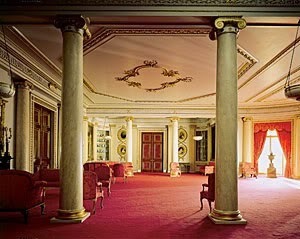 The Bow Room; Above pictures from the Royal Collection Trust © Her Majesty Queen Elizabeth II 2014
The Bow Room; Above pictures from the Royal Collection Trust © Her Majesty Queen Elizabeth II 2014At last I arrived at the final room, leading out onto the rear terraces of the Palace. I hurried outside and grabbed by cell phone to call Diane. No answer. Aha! I figured she and her companions, Marilyn and Kristine, were probably in the Palace by now and therefore couldn't take out a cell phone, or they'd risk being sent to the Tower. So I texted: "Waiting for you in the cafe tent."
 Visitors emerging from the Palace, my photos from here on
Visitors emerging from the Palace, my photos from here on The Queen's Backyard, aka Garden Lawn
The Queen's Backyard, aka Garden Lawn Decorative Urn
Decorative Urn More visitors emerging...
More visitors emerging...I figured I was considerably ahead of the others, so I bought myself a piece of cake and a cup of the Queen's tea, and sat down with a table full of amiable visitors taking refreshment after our long tour. Several were from Australia, one from Germany, another pair from Canada and, wonder of wonders, I was the only American. We had a fine chat about the palace, the royals and the beautiful garden. As you could imagine, the cake and tea were top notch.
 A pigeon made herself at home
A pigeon made herself at homeEventually, I saw Marilyn waving at me across the crowded tables, and I rejoined her -- and Kristine and Diane. "Where WERE you?" we asked each other. The only answer is that we had been unwilling and unconscious players in a British stage farce, the kind they do so brilliantly.
I enter, stage left. Walk around looking for my friends, I exit stage right. At that exact moment, they enter stage left, look around and soon disappear through the door at the back of the stage. I re-enter stage right and wander around, While behind a post, they enter from the door at the back of the stage, cross over and exit stage right. I reappear and exit stage left. Repeat for an hour or so, moving faster at every recap. The timing must have been perfection. We were all there in the Queen's Gallery, their gift shop, their facilities, the sitting wall outside. Back and forth we wandered looking for each other and never caught a glimpse. We couldn't repeat the farce if we tried!
 In the gift shop at the tent behind Buckingham Palace; Note Kristine's look of pain.Remember her feet???
In the gift shop at the tent behind Buckingham Palace; Note Kristine's look of pain.Remember her feet???
 The Buckingham Palace Garden; Wilderness and Lake
The Buckingham Palace Garden; Wilderness and LakeAlthough we weren't allowed to visit the flower gardens, we had a nice view of the lake and the wilderness as we exited through a gate at the rear of the garden.
 Some autumn blooming crocus along the path
Some autumn blooming crocus along the path Looking back at the Garden Facade of the Palace
Looking back at the Garden Facade of the Palace
As many have noted, this Nash-designed facade of the Palace, so rarely seen by the public, is the most beautiful, with its graceful bow and classical symmetry.
 Farewell to the Palace
Farewell to the PalaceLuckily, we could all laugh off our trials and tribulations since we now knew how to contact one another by 21st C technology. I felt reassured I hadn't been ditched. And we all had enjoyed our trek through the royal rooms, with the possible exception of Kristine, whose feet were still suffering. But she carried on in the best stiff-upper-lip mode!
Next: The History of Buckingham Palace
Published on March 06, 2015 00:30
March 4, 2015
VIDEO WEDNESDAY: ALAN RICKMAN
A LITTLE CHAOS
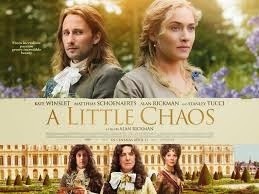
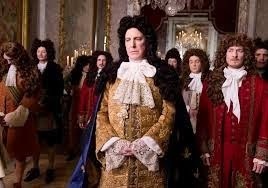
A romantic drama following Sabine (Academy Award winner Kate Winslet), a strong-willed and talented landscape designer, who is chosen to build one of the main gardens at King Louis XIV's new palace at Versailles. In her new position of power, she challenges gender and class barriers while also becoming professionally and romantically entangled with the court's renowned landscape artist André Le Notre (Matthias Schoenaerts)
Click here to watch the trailer

Click here to watch an interview with star and director of A Little Chaos Alan Rickman
and
A PROMISE
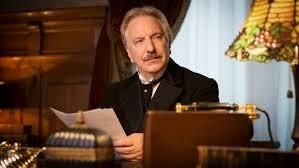
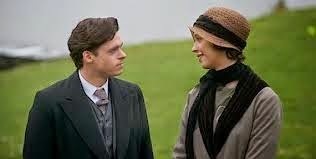
Germany 1912, a freshly graduated engineer with modest origins, Friedrich Zeitz, becomes the right hand of ageing tycoon Karl Hoffmeister. When Hoffmeister's degrading health condition starts to confine him permanently to his house, Friedrich has to visit him at home to get briefed. Thus Friedrich makes the acquaintance of Hoffmeister's younger wife Charlotte, a beautiful and reserved woman in her early 30s. He immediately becomes enamored with her and struggles with his growing unrequited feelings for her, not realizing they are reciprocated. Just as they disclose their mutual attraction towards one another, Friedrich has to leave the country to represent Hoffmeister overseas. The outbreak of World War I keeps him away from Germany for a long time. Only after the end of the war and many years of separation are Friedrich and Charlotte able to reunite.
Watch the trailer here
and finally . . . . . .

Watch an Alan Rickman-off with Benedict Cumberbatch and Jimmy Fallon - click here
Published on March 04, 2015 00:00
Kristine Hughes's Blog
- Kristine Hughes's profile
- 6 followers
Kristine Hughes isn't a Goodreads Author
(yet),
but they
do have a blog,
so here are some recent posts imported from
their feed.



